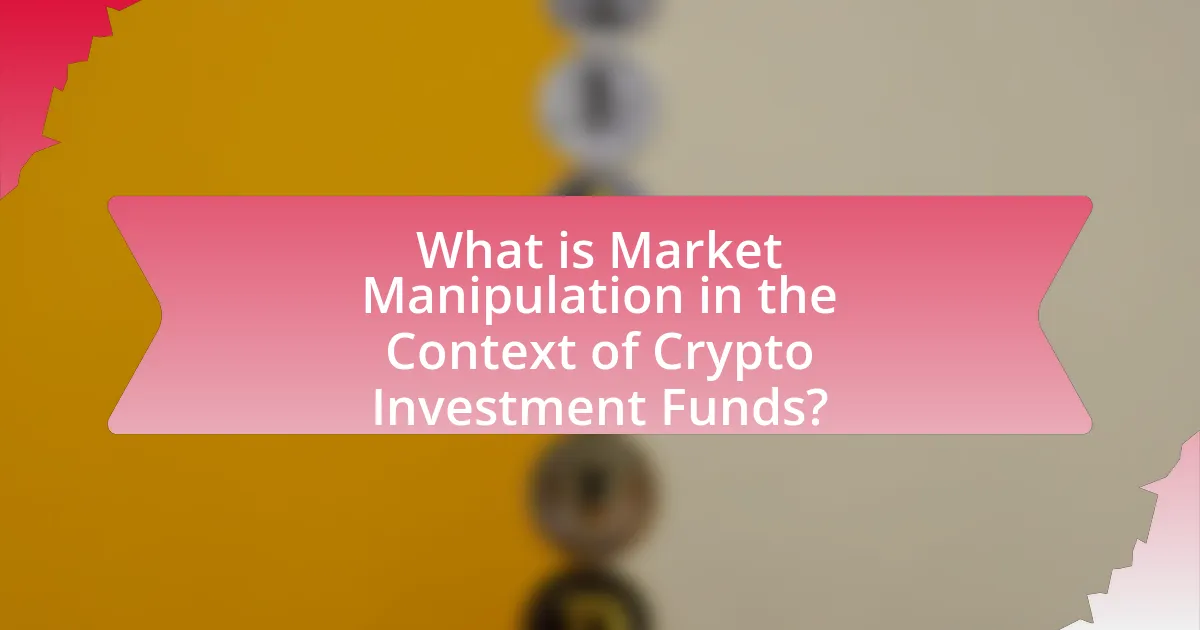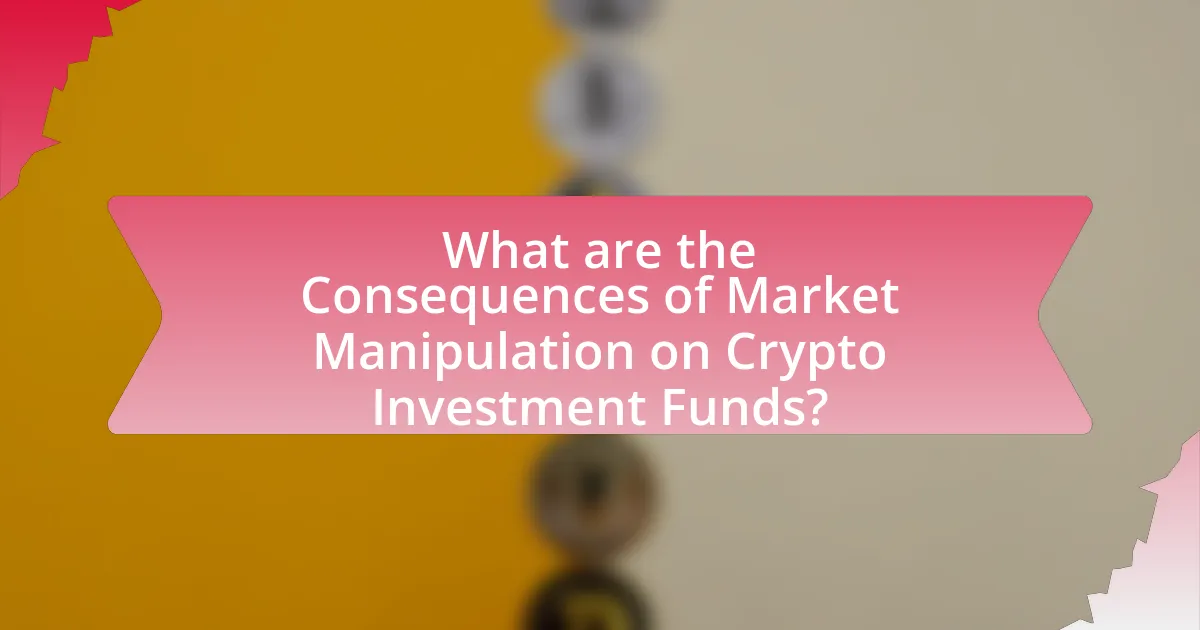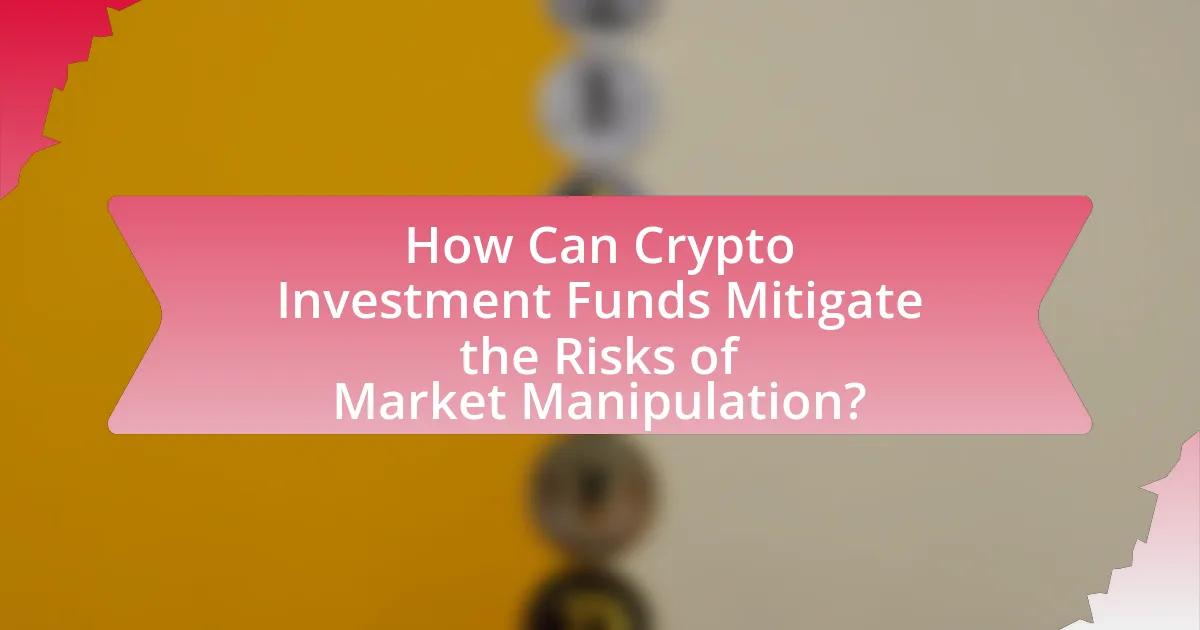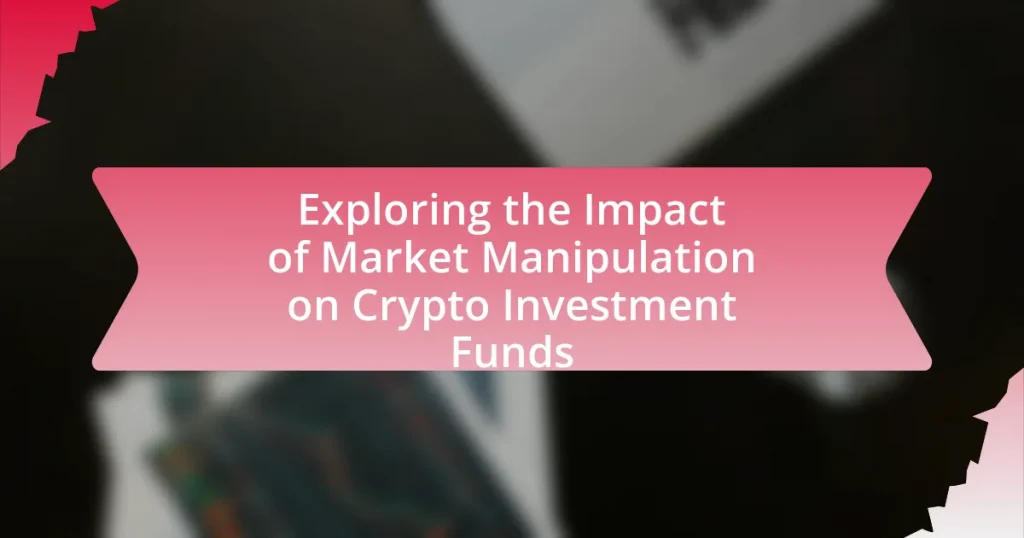Market manipulation significantly impacts crypto investment funds by artificially influencing cryptocurrency prices for personal gain. This article examines various tactics employed in market manipulation, such as pump-and-dump schemes, wash trading, and spoofing, which exploit the low regulation in the cryptocurrency market. It highlights the risks these manipulative practices pose to investor confidence, fund performance, and overall market integrity. Additionally, the article discusses regulatory responses, the role of exchanges in preventing manipulation, and strategies that investment funds can adopt to mitigate these risks, ultimately providing insights for investors to navigate the complexities of the crypto landscape.

What is Market Manipulation in the Context of Crypto Investment Funds?
Market manipulation in the context of crypto investment funds refers to the deliberate actions taken by individuals or groups to artificially influence the price of cryptocurrencies for personal gain. This manipulation can occur through various tactics, such as pump-and-dump schemes, where the price is inflated through misleading information, followed by a sell-off to profit from the inflated price. According to a report by the Blockchain Transparency Institute, over 80% of trading volume on certain exchanges is attributed to wash trading, a common form of market manipulation. This highlights the prevalence and impact of such practices within the crypto market, affecting the integrity and stability of investment funds.
How does market manipulation occur in the cryptocurrency space?
Market manipulation in the cryptocurrency space occurs through tactics such as pump-and-dump schemes, wash trading, and spoofing. In pump-and-dump schemes, manipulators artificially inflate the price of a cryptocurrency by spreading false information, leading unsuspecting investors to buy in, after which the manipulators sell off their holdings at the inflated price. Wash trading involves a trader buying and selling the same asset to create misleading activity, giving the illusion of high demand and liquidity. Spoofing entails placing large orders that are canceled before execution to create a false sense of market interest, influencing prices. These practices exploit the relatively low regulation and transparency in cryptocurrency markets, making them susceptible to manipulation. According to a 2020 study by the University of Technology Sydney, approximately 95% of trading volume on cryptocurrency exchanges is considered fake or non-genuine, highlighting the prevalence of such manipulative tactics.
What are the common tactics used for market manipulation?
Common tactics used for market manipulation include pump and dump schemes, spoofing, and wash trading. Pump and dump schemes involve artificially inflating the price of an asset through misleading information, followed by selling off the asset at the inflated price. Spoofing entails placing large orders to create a false impression of demand or supply, which can influence market prices. Wash trading involves buying and selling the same asset to create misleading activity and volume, giving the illusion of increased interest. These tactics are illegal and can lead to significant financial losses for unsuspecting investors.
How do these tactics specifically target crypto investment funds?
Market manipulation tactics specifically target crypto investment funds by creating artificial price movements that mislead investors. These tactics, such as pump-and-dump schemes, involve inflating the price of a cryptocurrency through false information or coordinated buying, leading unsuspecting investment funds to purchase at inflated prices. Once the price peaks, manipulators sell off their holdings, causing a sharp decline in value and resulting in significant losses for the investment funds that bought in during the manipulation. Historical instances, such as the Bitconnect collapse in 2018, illustrate how these tactics can devastate investment funds, as they were heavily invested in a scheme that was ultimately revealed to be fraudulent.
Why is understanding market manipulation important for investors?
Understanding market manipulation is crucial for investors because it directly affects their investment decisions and potential returns. Market manipulation can create artificial price movements, leading to misinformed trading strategies and financial losses. For instance, the U.S. Securities and Exchange Commission (SEC) has reported that schemes like pump-and-dump can inflate asset prices, misleading investors into buying at inflated values before the manipulators sell off their holdings. Recognizing these tactics enables investors to make informed choices, avoid scams, and protect their investments in volatile markets like cryptocurrencies, where manipulation is prevalent.
What risks does market manipulation pose to crypto investment funds?
Market manipulation poses significant risks to crypto investment funds, primarily by distorting market prices and leading to financial losses. When manipulative practices such as pump-and-dump schemes occur, they can create artificial price volatility, misleading investors about the true value of assets. This volatility can result in substantial losses for investment funds that are unable to react quickly to sudden market changes. Furthermore, market manipulation undermines investor confidence, which can lead to reduced participation in the market and lower overall liquidity. According to a report by the Financial Action Task Force, the prevalence of market manipulation in cryptocurrency markets is a major concern, highlighting the need for regulatory oversight to protect investors and ensure market integrity.
How can market manipulation affect investor confidence?
Market manipulation can significantly undermine investor confidence by creating an illusion of market stability or growth that is not based on genuine economic fundamentals. When investors perceive that prices are artificially inflated or deflated due to manipulative practices, they may lose trust in the market’s integrity. For instance, a study by the Financial Industry Regulatory Authority (FINRA) found that instances of market manipulation, such as pump-and-dump schemes, can lead to a 30% drop in investor participation in affected markets. This decline in participation further exacerbates volatility and uncertainty, reinforcing a cycle of distrust among investors.

What are the Consequences of Market Manipulation on Crypto Investment Funds?
Market manipulation significantly undermines the integrity and performance of crypto investment funds. Such manipulation can lead to inflated asset prices, resulting in substantial losses for investors when the market corrects itself. For instance, practices like pump-and-dump schemes artificially drive up the price of cryptocurrencies, enticing unsuspecting investors to buy in at peak prices, only for the manipulators to sell off their holdings, causing a sharp decline in value. According to a 2020 report by the Blockchain Transparency Institute, over 80% of trading volume on certain exchanges was found to be fake, highlighting the prevalence of manipulation and its potential to distort market perceptions. This not only erodes investor trust but also increases regulatory scrutiny, which can lead to stricter regulations that may stifle innovation within the crypto space.
How does market manipulation impact fund performance?
Market manipulation negatively impacts fund performance by distorting asset prices and creating artificial volatility. When manipulative practices, such as pump-and-dump schemes or wash trading, occur, they can lead to inflated valuations that do not reflect the true market conditions. This misrepresentation can result in significant losses for investment funds when the manipulated prices correct, as evidenced by the 2017 cryptocurrency market, where many funds experienced sharp declines after artificial price increases collapsed. Furthermore, funds may face increased risk and uncertainty, leading to poor investment decisions and reduced investor confidence, ultimately harming long-term performance.
What are the short-term effects of manipulation on fund returns?
Short-term manipulation typically leads to inflated fund returns, creating a misleading perception of performance. This occurs as manipulated trading activities, such as wash trading or pump-and-dump schemes, artificially boost asset prices, resulting in temporary gains. For instance, a study by the University of California, Berkeley, found that manipulated markets can experience price spikes of up to 30% within days, which misleads investors about the true value of the fund. Consequently, while these returns may appear attractive initially, they often lead to significant corrections once the manipulation ceases, ultimately harming long-term investor trust and fund stability.
How can long-term fund strategies be affected by manipulation?
Long-term fund strategies can be significantly affected by manipulation through distorted market signals that mislead investment decisions. When manipulative practices, such as pump-and-dump schemes or wash trading, occur, they create artificial price movements that can lead fund managers to make suboptimal investment choices based on inaccurate data. For instance, a study by the University of California, Berkeley, found that market manipulation can inflate asset prices by up to 30%, leading to misguided long-term investment strategies that do not reflect the true market value. This misalignment can result in substantial financial losses for funds that rely on manipulated data to guide their investment decisions.
What regulatory responses exist to combat market manipulation?
Regulatory responses to combat market manipulation include the implementation of strict laws and enforcement actions by financial authorities. For instance, the Securities and Exchange Commission (SEC) in the United States enforces regulations such as the Securities Exchange Act of 1934, which prohibits manipulative practices like insider trading and pump-and-dump schemes. Additionally, the Commodity Futures Trading Commission (CFTC) oversees derivatives markets and has the authority to prosecute manipulative conduct under the Commodity Exchange Act. These regulatory bodies actively monitor trading activities, impose penalties, and promote transparency to deter market manipulation. Historical data shows that enforcement actions have increased significantly, with the SEC filing over 800 cases related to market manipulation from 2010 to 2020, demonstrating a commitment to maintaining market integrity.
How effective are current regulations in protecting investors?
Current regulations are moderately effective in protecting investors, particularly in traditional financial markets, but they often lag in the rapidly evolving cryptocurrency sector. Regulatory bodies like the SEC have implemented rules to enhance transparency and reduce fraud, yet many crypto assets remain unregulated, exposing investors to significant risks. For instance, a 2021 report by the Financial Stability Board highlighted that over 90% of crypto exchanges operate without adequate oversight, leading to potential market manipulation and investor losses. This gap in regulation underscores the need for more comprehensive frameworks to safeguard investors in the crypto space.
What role do exchanges play in preventing market manipulation?
Exchanges play a crucial role in preventing market manipulation by implementing surveillance systems and regulatory compliance measures. These systems monitor trading activities for suspicious patterns, such as wash trading or spoofing, which are indicative of manipulation. For instance, many exchanges utilize algorithms that analyze trading data in real-time to detect anomalies and enforce trading rules. Additionally, exchanges often require users to undergo Know Your Customer (KYC) procedures, which help to identify and limit the activities of malicious actors. According to a report by the Financial Action Task Force (FATF), effective regulatory frameworks and compliance measures significantly reduce the risk of market manipulation in cryptocurrency markets.

How Can Crypto Investment Funds Mitigate the Risks of Market Manipulation?
Crypto investment funds can mitigate the risks of market manipulation by implementing robust compliance measures and utilizing advanced technology for monitoring trading activities. These funds often employ real-time surveillance systems that analyze trading patterns and detect anomalies indicative of manipulation, such as wash trading or spoofing. For instance, according to a report by the Financial Action Task Force (FATF), effective monitoring can reduce the incidence of market manipulation by up to 30% in regulated environments. Additionally, establishing clear governance frameworks and adhering to regulatory guidelines enhances transparency and accountability, further reducing the likelihood of manipulative practices.
What strategies can funds implement to protect against manipulation?
Funds can implement several strategies to protect against manipulation, including employing advanced surveillance technology, conducting thorough due diligence, and diversifying their investment portfolios. Advanced surveillance technology allows funds to monitor trading patterns and detect unusual activities that may indicate manipulation. For instance, the use of machine learning algorithms can analyze vast amounts of trading data in real-time, identifying anomalies that warrant further investigation.
Conducting thorough due diligence involves scrutinizing the backgrounds of counterparties and assessing the integrity of the exchanges where trades occur. This practice helps funds avoid engaging with potentially manipulative entities. Additionally, diversifying investment portfolios across various assets and markets reduces the risk associated with any single investment being manipulated. According to a report by the Financial Action Task Force, diversification is a key risk management strategy that can mitigate the impact of market manipulation on overall fund performance.
How can technology be leveraged to detect and prevent manipulation?
Technology can be leveraged to detect and prevent manipulation through advanced algorithms and machine learning models that analyze trading patterns and market behaviors. These technologies can identify anomalies, such as sudden price spikes or unusual trading volumes, which may indicate manipulative activities like pump-and-dump schemes. For instance, the implementation of real-time surveillance systems in cryptocurrency exchanges has proven effective; a study by the Financial Action Task Force highlighted that exchanges employing such systems reported a 30% decrease in suspicious trading activities. Additionally, blockchain technology enhances transparency, allowing for the tracking of transactions and the identification of irregularities, further aiding in the prevention of manipulation.
What best practices should funds adopt for transparency and reporting?
Funds should adopt best practices such as regular and detailed reporting, independent audits, and clear communication of investment strategies to enhance transparency and reporting. Regular reporting ensures stakeholders receive timely updates on fund performance and risk factors, which is crucial in the volatile crypto market. Independent audits provide an objective assessment of financial statements, reinforcing trust among investors. Clear communication of investment strategies helps investors understand the fund’s approach and risk exposure, which is particularly important in the context of market manipulation risks that can affect crypto investment funds. These practices collectively foster accountability and build investor confidence.
What resources are available for investors to understand market manipulation?
Investors can utilize various resources to understand market manipulation, including regulatory agency publications, academic research, and financial news outlets. The U.S. Securities and Exchange Commission (SEC) provides guidelines and reports on market manipulation practices, which are essential for investors to recognize illegal activities. Academic studies, such as “Market Manipulation: A Review of the Literature” by Allen and Gale, offer insights into the mechanisms and effects of manipulation. Additionally, financial news platforms like Bloomberg and Reuters frequently cover incidents of market manipulation, providing real-time analysis and expert opinions. These resources collectively equip investors with the knowledge to identify and respond to market manipulation effectively.
How can investors educate themselves about market manipulation risks?
Investors can educate themselves about market manipulation risks by studying regulatory guidelines, market behavior, and educational resources. Regulatory bodies like the Securities and Exchange Commission (SEC) provide detailed information on what constitutes market manipulation and the legal ramifications, which can help investors recognize red flags. Additionally, analyzing historical cases of market manipulation, such as the 2010 Flash Crash, offers insights into how such events unfold and their impact on markets. Online courses, webinars, and publications from reputable financial institutions also serve as valuable resources for understanding manipulation tactics and protective strategies.
What tools can investors use to analyze market trends and behaviors?
Investors can use various tools to analyze market trends and behaviors, including technical analysis software, charting platforms, and data analytics tools. Technical analysis software, such as MetaTrader and TradingView, allows investors to study price movements and identify patterns through indicators and charts. Charting platforms provide visual representations of market data, enabling investors to track historical trends and make informed predictions. Data analytics tools, like Bloomberg Terminal and CoinMarketCap, aggregate vast amounts of market data, offering insights into trading volumes, price changes, and market sentiment. These tools are essential for investors to make data-driven decisions and understand market dynamics effectively.
What are the best practices for investing in crypto funds amidst manipulation risks?
The best practices for investing in crypto funds amidst manipulation risks include conducting thorough due diligence, diversifying investments, and utilizing reputable platforms. Investors should research the fund’s management team, track record, and regulatory compliance to ensure credibility. Diversification across various crypto assets can mitigate risks associated with individual asset manipulation. Additionally, using established and regulated exchanges reduces exposure to fraudulent activities, as these platforms often have safeguards against manipulation. According to a report by the Financial Action Task Force, transparency and regulatory oversight are crucial in minimizing manipulation risks in cryptocurrency markets.















